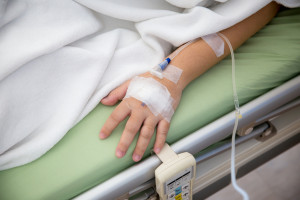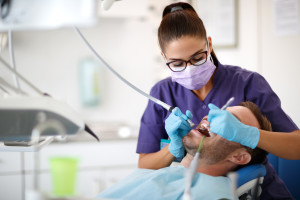Oncology Drug Programs: An Expert on Diagnostic Lump Sum and the Inverted Benefit Pyramid

- Although there is so much talk about the inverted pyramid of benefits, in the case of oncological drug programs, the pricing of benefits does not encourage it - says Izabela Obarska
- The outpatient mode is priced disproportionately low compared to one-day hospitalization, although in fact the patient's care looks similar in both cases. This disproportion in pricing means that hospitals are more willing to use the one-day mode. - indicates
- Outpatient admissions and generally services in the chemotherapy catalogue are also priced better, which also influences the fact that some healthcare providers prefer these particular drugs - he points out.
- It is also necessary to look at the diagnostic flat-rate, which includes tests performed as part of the qualification for the drug program, as well as monitoring and treatment in the program - he adds.
- Drug programs are currently a necessity. For now, we can only wonder how they can evolve in our system - said Izabela Obarska , an expert in the health care system, during a meeting of the Parliamentary Team for Men's Health.
As she emphasized, several aspects should be taken into account. The first is of course the new drugs that will appear in the programs, but it is also important how healthcare services are priced in drug programs. This is especially true for diagnostic tests (whether all of them are included in the diagnostic flat-rate). Moreover, if we are dealing with new therapies, the appropriate services in the drug program must evolve, i.e. separate monitoring and separate tests for qualification, so that the hospital implementing the program does not have to lose financially.
Many more patients could qualify for treatment in the programs- At the moment, the evolution of the valuation of the benefit is very slow. It takes place after months or even years. Despite this, some hospitals treat patients with drugs that are optimal for them at a given moment, but some do not undertake this . All the more so now, when the financial situation of the National Health Fund is difficult, and the delays in financing drug programs are very large . This results in limiting entry into programs, especially high-cost ones. As you can see, this is therefore a very difficult scope of drug reimbursement - indicated Izabela Obarska.
As an example, she cited the B.141 drug program dedicated to patients with urothelial cancer , in which avelumab is used as maintenance treatment in the first line, nivolumab in adjuvant treatment and enfortumab vedotin in monotherapy in the second and third lines.
- According to the National Health Fund data for 2023-24, there are slightly over 900 patients in this drug program. Avelumab therapy dominates - in 2024, it was used to treat approximately 550 patients. 210 patients used enfortumab vedotin therapy, and 177 patients were treated with nivolumab. Compared to the population that could qualify for treatment, this is a very small number - assessed the expert.
She added that new therapeutic options may appear in the B.141 drug program. Currently, the president of AOTMiT has issued positive recommendations for three therapies: pembrolizumab, nivolumab in combination with cisplatin and gemcitabine, and erdafitinib, an oral drug in monotherapy.
As Izabela Obarska pointed out, the B.141 drug program is implemented by about 100 service providers, with the highest density of centers in the following voivodeships: Mazowieckie (12), Łódzkie and Dolnośląskie (11 each) , Śląskie and Wielkopolskie (10 each). She also reminded that the obligations of service providers implementing the drug program are much greater than in the case of other types of services - they were included in detail in the order of the president of the National Health Fund.
"The pricing of benefits in drug programs does not encourage the reversal of the pyramid"- How is the drug program financed? The costs of implementation are settled completely differently than the costs of other services. Separate agreements are concluded for each program. The costs of drugs are settled separately, after the purchase invoice. A separate item in this agreement is the cost of services, which include medical consultations, hospitalizations and diagnostic tests - explained the expert.
She added that when it comes to the urothelial cancer program, in 2024 the costs of services amounted to over PLN 9 million , while over PLN 64 million were the costs of drugs financed by the National Health Fund, and approximately PLN 20 million was the cost of the drug financed by the Medical Fund.
- In terms of pricing, the B.141 program includes three modes: outpatient, one-day and hospitalization. If the aforementioned oral drug is included in the drug program, it should be administered on an outpatient basis, unless of course there are adverse effects. However, the outpatient mode is priced the lowest, disproportionately low compared to one-day hospitalization , although in fact the patient's supply looks similar in both cases - said Izabela Obarska.
- This disproportion in pricing means that hospitals are more willing to use the one-day mode. Although we constantly talk about the need to reverse the pyramid of benefits, the pricing of benefits in oncology drug programs does not encourage this - she noted.
- It is also impossible to ignore the fact that outpatient admission and generally benefits in the chemotherapy catalog are more highly valued , which also influences the fact that some service providers prefer these particular drugs. This means that the service provider is not supported in choosing the best therapeutic option for the patient . This also means that the pyramid of benefits should be reversed not only in the system, but also in drug programs - assessed Izabela Obarska.
"The diagnostic fee should increase the moment the drug is included in the program"In its assessment, it is also necessary to look at the diagnostic lump sum, which includes tests performed as part of qualification for the drug programme, as well as as part of monitoring and treatment in the programme.
- Previously, the flat fee was actually an average cost of diagnostic tests. Now, when many therapies are emerging, each of which requires an individual approach to qualification and monitoring, the tests have become more cost-intensive. The Fund has therefore started to apply a slightly higher flat fee for the first year in the program, because then the costs, taking into account qualifications, are the highest. There has also been diversification depending on the drug used to treat the patient - explained the expert.
She added that in the B.141 program, diagnostics in the first year are priced at PLN 3,600 , and in the second year and subsequent years at PLN 2,539 . There is also a catalog to be summed up regarding genetic tests, if they must be performed, with three baskets of tests available: basic, complex and advanced. The catalog to be summed up will have to be used in the B.141 program if erdafitinib therapy is introduced.
- In the case of this therapy, ophthalmological tests will also be necessary, the cost of which significantly differs from the diagnostic lump sum. This means that the diagnostic lump sum should be automatically increased by the National Health Fund when the drug is included in the drug program, and in the first year it should amount to over PLN 6,000. Otherwise, either patients will not be properly monitored, although such requirements will be in the program, or the hospital will not receive reimbursement for the tests - Obarska emphasized.
rynekzdrowia












